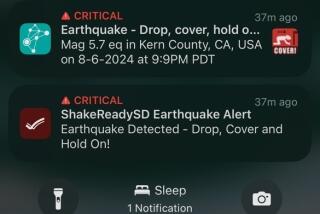Quake Valve Redux
Regarding Ralph Cohenâs letter (July 8) in response to my article âGas Shut-off Valve Reduces Fire Risk After Major Quake.â (June 24).
I disagree with Ralph Cohenâs (spokesman for the Southern California Gas Co.) point that automatic shut-off valves are unnecessary because strapping a homeâs gas water heater provides ample earthquake gas fire protection.
If fires from gas leaks are so minimal, why does the Gas Co. recommend that we all know how to shut the gas off at the meter with a wrench?
As we all witnessed via television from the San Francisco Marina District following last yearâs earthquake and from Whittier following the Oct. 1, 1987 quake, gas fires are not unusual after a temblor.
While the proportion of homes lost to gas fires in the relatively small, and the earthquakes we have had may not be huge, quake experts are warning us that we are due for a temblor of 8.3 or greater, perhaps within 30 years.
It does not seem unreasonable to conclude that damage to gas lines and appliances resulting in catastrophic fires will be much more widespread following a quake many times more powerful than we have experienced since 1906.
While strapping a water heater is not a bad idea, it does not assure complete safety.
Following the 1987 Whittier quake, many strapped water heaters pulled loose from their anchor points because they were not properly secured or because the wall they were attached to simply collapsed.
The tank must be strapped with heavy-duty plumberâs steel tape secured with bolts at least 2 1/2 inches in length driven into the wall studs.
Although I do agree that falling water heaters present a serious gas earthquake hazard, by no means are they the only household hazard. For example, following the July 21, 1957 Arvin-Tehachapi earthquake in Kern County, one man was killed in his home when a stove exploded after gas escaping from its earthquake-damaged supply line ignited.
Also, the L.A. County Fire Department reports that one garage fire was ignited during the 1987 Whittier quake when fumes from a knocked-over gas can were ignited by a water heater pilot flame.
Cohen also makes the point that if homes are left without gas for heating or cooking after a major quake while residents await restoration of gas service when the valves shut, that it â. . . could impair the health of infants, the elderly, the infirm and others. . . .â
During every other major disaster we have faced in this country, temporary shelter has been provided for those made homeless or displaced.
The Southern California Gas Co. and other public safety officials have long been giving us mixed messages about safety during an earthquake. On one hand they advise manually shutting off the gas at the meter (we have all received instruction cards with our gas bills) if leaking gas is detected, while on the other hand, they suggest not going outside during a quake to avoid being hit by falling objects!
Gas leaking in a confined space can create an explosion hazard very rapidly. If we are to wait for the shaking to stop before going outside to shut off the gas, it could be too late as shaking during a major quake can go on a long time. For example, during the 1964 Alaska quake, the ground shook for almost four minutes.
An automatic valve is a practical answer to this dilemma.
GARY ABRAMS
Los Angeles
Abrams is a general contractor and free-lance writer.
More to Read
Sign up for Essential California
The most important California stories and recommendations in your inbox every morning.
You may occasionally receive promotional content from the Los Angeles Times.










